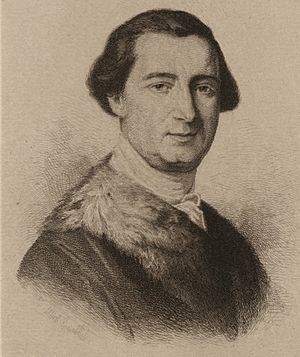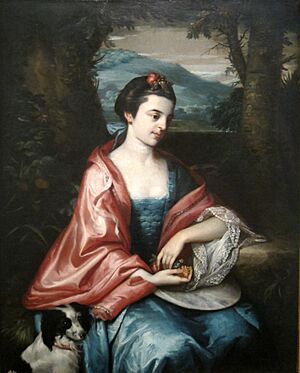John Penn (governor) facts for kids
Quick facts for kids
John Penn
|
|
|---|---|

Etching of John Penn by Albert Rosenthal
|
|
| Governor of the Province of Pennsylvania | |
| In office 1773–1776 |
|
| Preceded by | Richard Penn |
| Succeeded by | Thomas Wharton Jr. (as President of Pennsylvania) |
| In office 1763–1771 |
|
| Preceded by | James Hamilton |
| Succeeded by | Richard Penn |
| Personal details | |
| Born | 14 July 1729 London, England |
| Died | 9 February 1795 (aged 65) Pennsylvania, United States |
| Spouses |
Grace Cox
(m. 1747, dissolved)Anne Allen
(after 1766) |
| Relations | Thomas Penn (brother) Richard Penn Jr. (brother) |
| Children | John Penn |
| Parents | Richard Penn Hannah Lardner Penn |
John Penn (born July 14, 1729 – died February 9, 1795) was an important leader in early America. He was the very last governor of colonial Pennsylvania. He served two times: first from 1763 to 1771, and then again from 1773 to 1776.
John Penn was also one of the proprietors of Pennsylvania. This means his family, the Penns, owned a large part of the land. He held a one-fourth share of this ownership from 1771 until 1776. However, when the American Revolution began, Pennsylvania became an independent state. This change removed the Penn family from their powerful position.
After the British left Philadelphia, John Penn and his wife returned. The new government took back the unsold lands that the Penn family owned. But they did give John Penn and his cousin, John Penn "of Stoke", some money as payment. They also asked the British Parliament for more money, and they received it.
Contents
Early Life and Education
John Penn was born in London, England. He was the oldest son of Richard Penn and Hannah Lardner. His father, Richard, had inherited a share of Pennsylvania from his own father, William Penn. William Penn was the founder of Pennsylvania.
This ownership gave the family a good income. Richard's older brother, Thomas Penn, owned three-fourths of the Pennsylvania lands. Since Thomas did not have any sons when John was young, it seemed John would inherit all the family's land in Pennsylvania. The family cared a lot about how John was raised and how he behaved.
First Marriage and Studies
In 1747, when John Penn was 18, he married Grace Cox. His family did not approve of this marriage. They thought Grace married him only for his family's money. John's father was very upset about it.
To get John away from his wife, his uncle Thomas sent him to Geneva, Switzerland, to study. John did not try to contact Grace during this time. The marriage ended, but it is not known exactly how. They did not have any children.
Moving to Pennsylvania
John Penn first came to Pennsylvania in 1752. His uncle Thomas sent him to learn about politics from Governor James Hamilton. John joined the governor's council. Here, he met important people like Richard Peters and William Allen.
In 1754, John Penn attended the Albany Congress. This meeting brought together leaders from seven colonies. They met to plan how to defend themselves against the French and Native Americans. This was before the French and Indian War, which was part of a bigger war between Britain and France. John Penn was mainly there to observe and learn.
However, John's uncle Thomas in England soon worried about John's high spending. John was spending a lot of money. Because of this, Thomas Penn called his nephew back to England in late 1755.
Becoming Governor

In 1763, Thomas Penn sent John Penn back to Pennsylvania. He was to become the new governor, taking over from Governor Hamilton. The Penn family believed John was ready to lead the colony.
John Penn officially became governor on October 31, 1763. He served until 1771 in his first term. He faced many challenges:
- Pontiac's War, a conflict with Native American tribes.
- The Paxton Boys, a group of settlers who attacked Native Americans.
- Disputes over borders with other colonies.
- Arguments about taxing the Penn family's lands.
- Efforts by the Pennsylvania Provincial Assembly, led by Benjamin Franklin, to change the government.
In 1768, John Penn was chosen to join the American Philosophical Society. This important group was founded by Benjamin Franklin.
Second Marriage and Family
In 1766, John Penn married Anne Allen. She was the daughter of William Allen, a well-known person in Philadelphia.
In 1771, John had to return to England after his father died. He took over his father's role as one of the owners of Pennsylvania. His brother, Richard Penn Jr., became governor in his place.
Second Time as Governor
Thomas Penn was not happy with Richard Jr.'s work as governor. So, in 1773, he arranged for John Penn to become governor again. John returned to Pennsylvania with his family and served until 1776. That year, the new revolutionary government took control during the American Revolution.
Thomas Penn had died in 1775. His son, John Penn "of Stoke", inherited the main ownership of the lands. This younger John Penn was only 15 when his father died. A guardian was assigned to manage his property until he was old enough. However, the Revolution soon changed everything.
American Revolution
The Penn family did not realize how much the growing unrest would affect their land ownership. In 1774, Governor Penn refused to call the Assembly together. This meant they could not choose delegates for the First Continental Congress. But in 1775, American patriots took control, leaving Penn powerless.
The war began with the Battles of Lexington and Concord. Penn watched as Pennsylvania colonists formed groups of soldiers and got ready for war. After the Declaration of Independence was signed, patriots in Pennsylvania created a new government. This new government replaced Penn's rule.
With no power left, Penn stayed out of the conflict. He hoped that the revolutionaries would either be defeated or make peace with the king.
The war started to go badly for the patriots. In August 1777, British General William Howe began his plan to capture Philadelphia. Patriot soldiers came to Penn's home near Philadelphia. They asked him to sign a paper saying he would not harm the revolution. Penn refused and was put under house arrest in Philadelphia.
As Howe's army got closer, the patriots threatened to send Penn to another colony. So, he signed the paper. With Howe near Philadelphia, patriot leaders decided to send Penn to an Allen family estate in New Jersey. This place was about 50 miles (80 km) from Philadelphia.
Anne Penn, John's wife, stayed in Philadelphia at first. She looked after family matters while the British were there. Later, she joined her husband in New Jersey.
After the British left Philadelphia in 1778, the Penns returned to the city in July. The new Pennsylvania government required everyone to promise loyalty to the state. If they refused, their property could be taken away. With his family's agreement, John Penn took the oath.
This protected Penn's private lands. However, the Pennsylvania Assembly passed a law in 1779. This law took away about 24 million acres (9.7 million hectares) of unsold land owned by the Penn family. It also stopped the practice of paying rent for new land purchases. As payment, John Penn and his cousin received £130,000. This was much less than the land was worth, but it was still a large amount. In some places, loyalist property was taken without any payment. Penn then retired to his home and waited for the war to end in 1781.
Later Life
For several years after the war, John Penn and his cousin, John Penn "of Stoke", tried to get more money for their confiscated property. John Penn "of Stoke" had inherited three-fourths of the family's land.
When they failed to get more money in Pennsylvania, they went to England in 1789. They asked the British Parliament for payment. Parliament gave the Penn cousins a total of £4,000 per year forever. (John Penn "of Stoke" stayed in England and became a Member of Parliament.)
John Penn returned to Pennsylvania and lived quietly with his family at his home. He died in 1795 and was buried under the floor of Christ Church, Philadelphia. He is the only Penn family owner to be buried in Pennsylvania. Some old stories say his body was later moved back to England, but there are no records to prove this.

